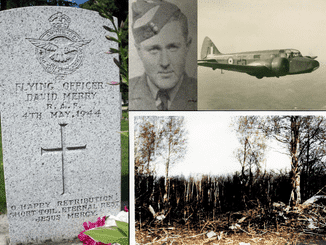
On 3 May 1944 LAC Cyril Devaux takes his first familiarization flight on the Cessna Crane type with instructor F/O Larsen as 1st Pilot. Three flights entered in his log book for 7, 8 and 9th May are recorded as “PASSENGER (STD. SEARCH).
These three flights intrigued us when processing the manual transfer of log book entries to a digital database. At the time they registered as something to return to at a later date as they appeared to be part of something outside of the normal training program.
Returning to these flights diving and deep into the reason behind them we unraveled not only a harrowing story of loss, but also one of a future family tie.
Lets make it coherent.
Reporting for duty
Fifty-three students reports to Course 106 at No. 3 SFTS Calgary on 8 April 1944 and Cyril Devaux is one of them. He has graduated from elementary flying training at 5 EFTS High River a few weeks earlier. This next leg of the journey is to earn his Pilot Wings on the twin engine Cessna Crane that will be the stepping stone towards becoming an operational pilot.
The reality and hazards involved in flight training would have become immediately apparent to Devaux. This day the station conducts a funeral for flying instructor F/O S.A Coffin (J2481) killed in an accident 2 April 1944.
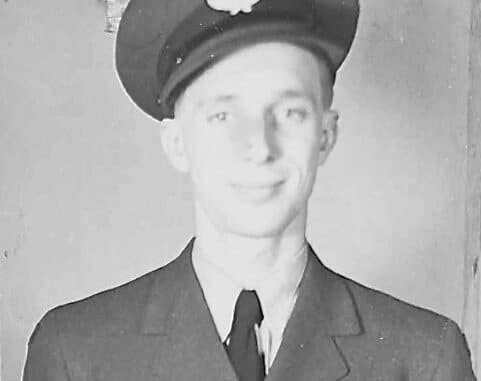
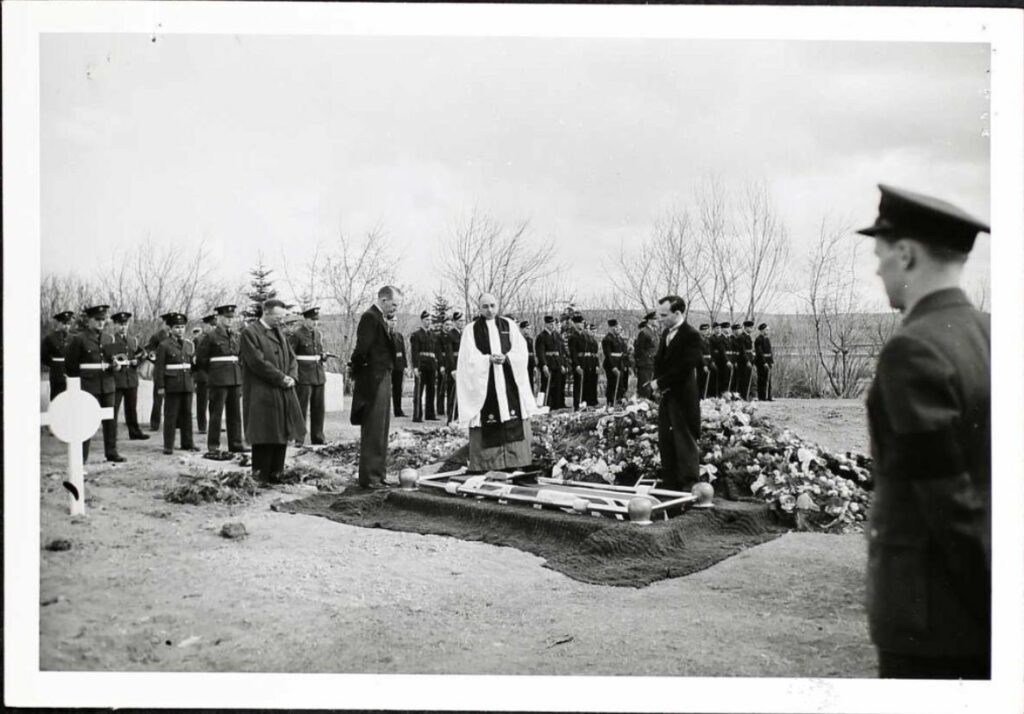
The station also records a category “A” crash on 16 April when Cessna Crane 7892 with 3 occupants strikes a telephone line and crashes into the ground west of aerodrome leaving both pupils on the “dangerously ill list”.
A failed return
No 36 SFTS Penhold is a similar station part of the BCATP southeast of Red Deer. Located some 130 km north of Calgary the aerodrome is today in existence as the Red Deer regional Airport. The purpose of the school, as with No. 3 SFTS Calgary, is to train future pilots of multi-engine aircraft to wings standard. The station was operating the twin engine Airspeed Oxford and had 4 courses in training at once.
In the early hours of 5 May 1944 it becomes apparent that one of No 36 SFTS Penhold’s aircraft had failed to return after a night training flight. In the daily diary of No. 3 SFTS Calgary the 5 May 1944 has the following entry.
A message was received from No. 36 SFTS Penhold requesting this Unit to carry out standard search in Areas 1 and 3 for Oxford Aircraft X6734…
No. 3 SFTS Calgary dialy diary of 5 May 1944
Over the entire region BCATP stations answer the request and No 3 SFTS Calgary alone commits 12 aircraft to the initial search effort on 5 May 1944. Poor visibility conditions due to smoke from wildfires on 6 May prevents No 3 SFTS Calgary from participating in the search.
Flights of 7-8-9 May 1944
It is obvious that LAC Devaux is very much participating in the search efforts mounted to find the missing Oxford aircraft. His log book records 3 flights as 2nd Pilot over the next few days and range from 2-3 hrs of flight time each.
The three flights are entered as “PASSENGER (STD. SEARCH)” in the ‘DUTY’ column and the flight time in the ‘PASSENGER’ column. Combined it is a clear indication that these flights were no training flights but missions with a very real purpose.
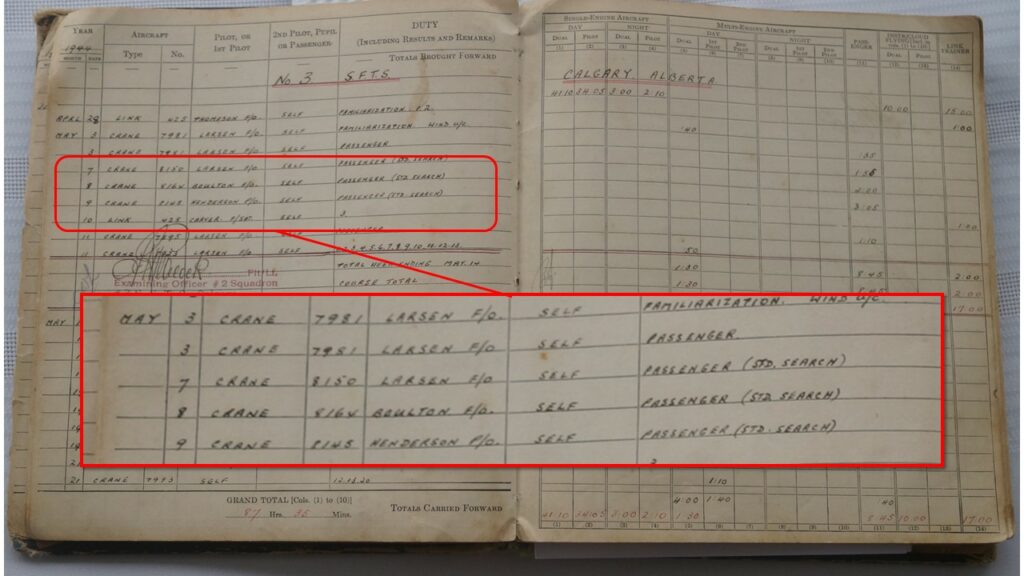

The scale of the search is enormous, No. 3 SFTS Calgary alone performs a total of 59 flights on 7 May 1944 covering a total of 16 000 miles. Devaux flies one of these sorties with F/O Larsen (his primary instructor) in Cessna Crane 8150 logging a total of 1 hrs 55 minutes of flight time.
Over 8-9th May 1944 LAC Devaux participates in 2 more of the 283 sorties flown in the search over the two days. On the 8th alone 53 aircraft at No. 3 SFTS Calgary are committed to the search operation.
The grim conclusion
Shortly before noon on 10th May 1944, five days after the disappearance, F/Lt Rupert Mitchell (74723) is flying a search pattern south of No. 36 SFTS Penhold. His keen eye spots a burnt out wreckage in a thick grove of poplar trees only a few miles south of the aerodrome. Due to fire most of the yellow fabric covering fuselage and wings is destroyed. There is only a black spot among the trees.
F/Lt. Mitchell showed remarkable acuity of vision in discovering the crashed aircraft, for it is certain that a number of pilots had previously flown over or near it. Even an experienced instructor who was informed of the position of the crash was unable to locate it when flying in the vicinity at 1,000 feet, so hidden by the trees was the wreckage.
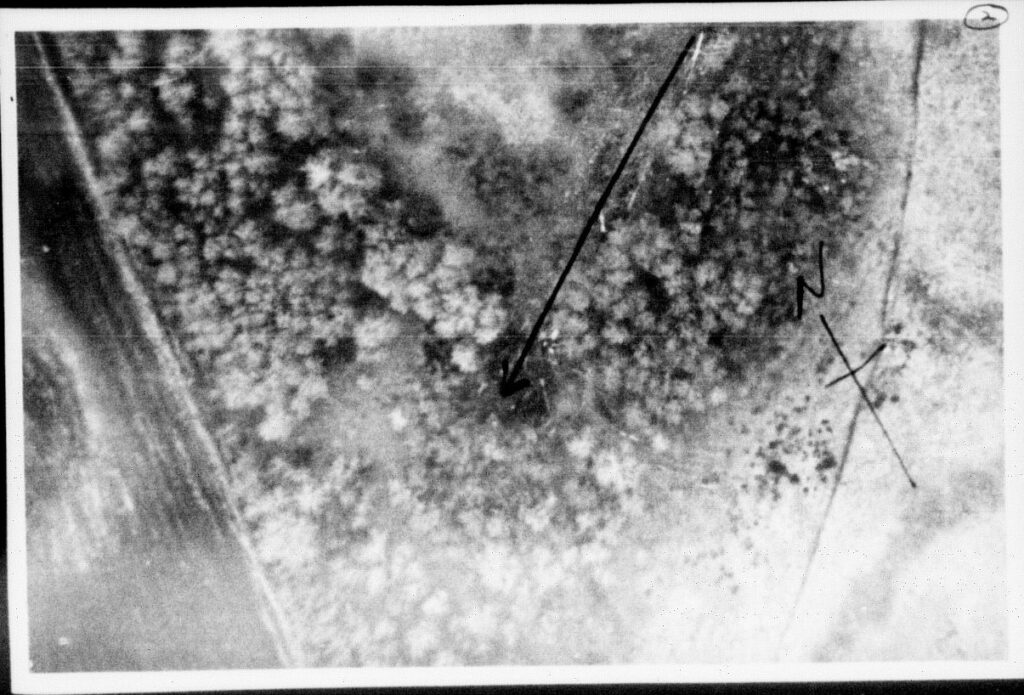
The final flight of Airspeed Oxford X6734
Oxford X6734 had taken off from runway 20 on No. 36 SFTS Penhold around 23:46 on 4 may 1944. The flight is a dual night cross country exercise from Base to Bashaw, about 50 miles north east of the station, and back to base.
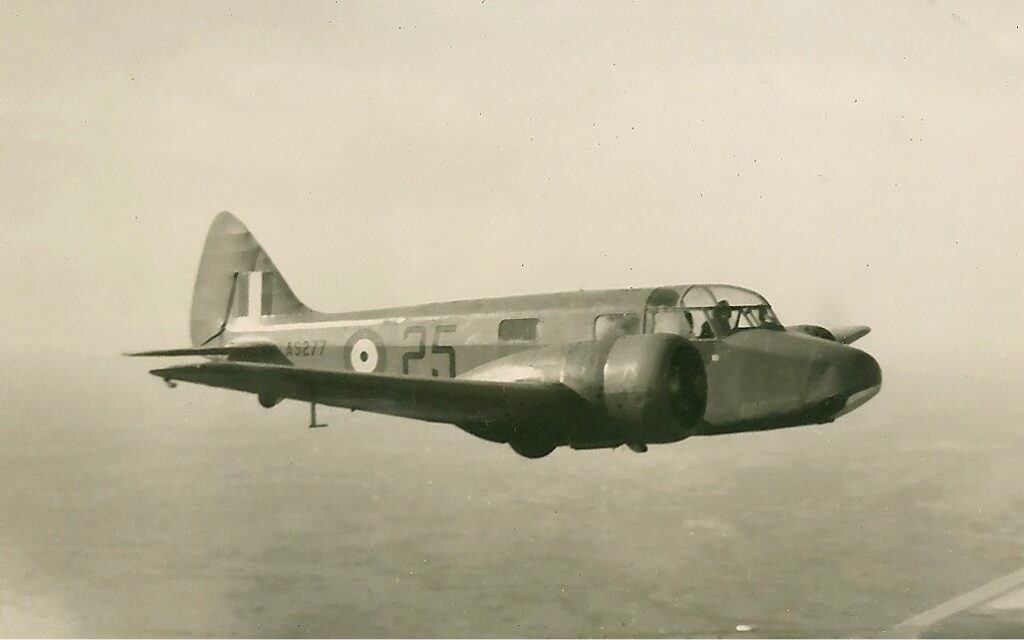
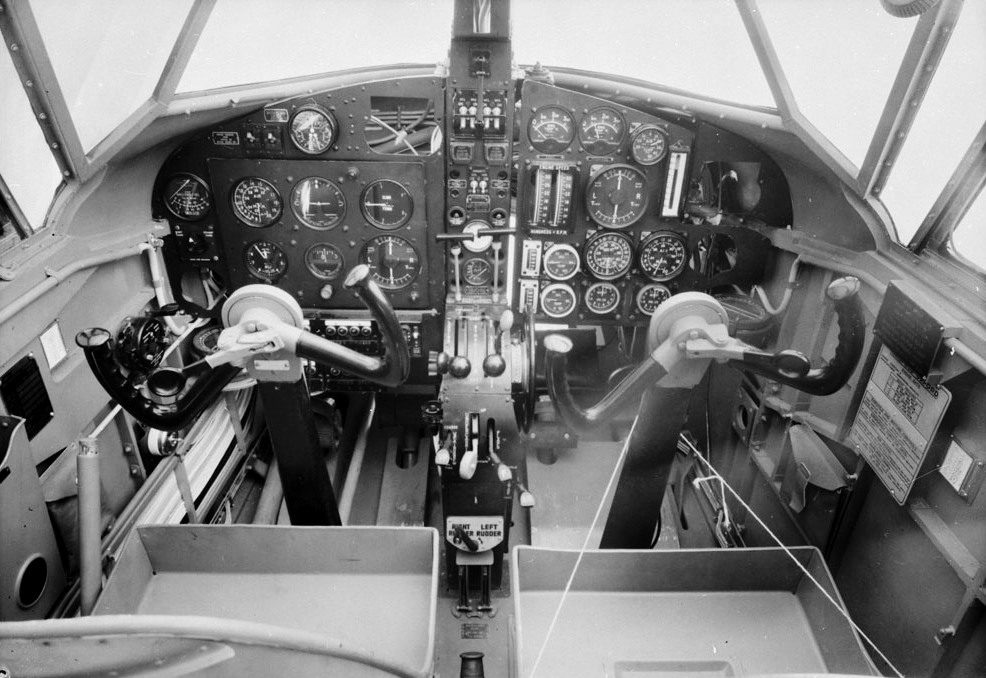
(Library and Archives Canada Photo, MIKAN No. 3581274)
In the left seat is pupil pilot LAC George D Conway (NZ435950), a 19 year old from Bluff in southern New Zealand.
Instructor F/O David Merry (135135), a 21 year old Tobagonian from Port of Spain, Trinidad, is flying right seat. The flight will be his 3rd cross country training flight of the night as he already completed flights with pupils P/O Cameron and LAC Finlay earlier.
Unbeknownst to F/O Merry and LAC Conway they will be taking off and fly into a wall of darkness never to be seen alive again.
The crash site
A ground party reaches the location at approximately 14:30 hours on 10 May 1944. The two occupants, instructor F/O Merry (135135) and pupil LAC Conway (NZ435950), are found deceased at the crash site.
It is determined the aircraft approached from a north easterly direction and impacted the ground wings level. The aircraft sheared off a number of small trees about 15 feet above the ground at the same height in the first 20 feet, then the shearing action began to tip towards the ground all the way to where shearing was at ground level.
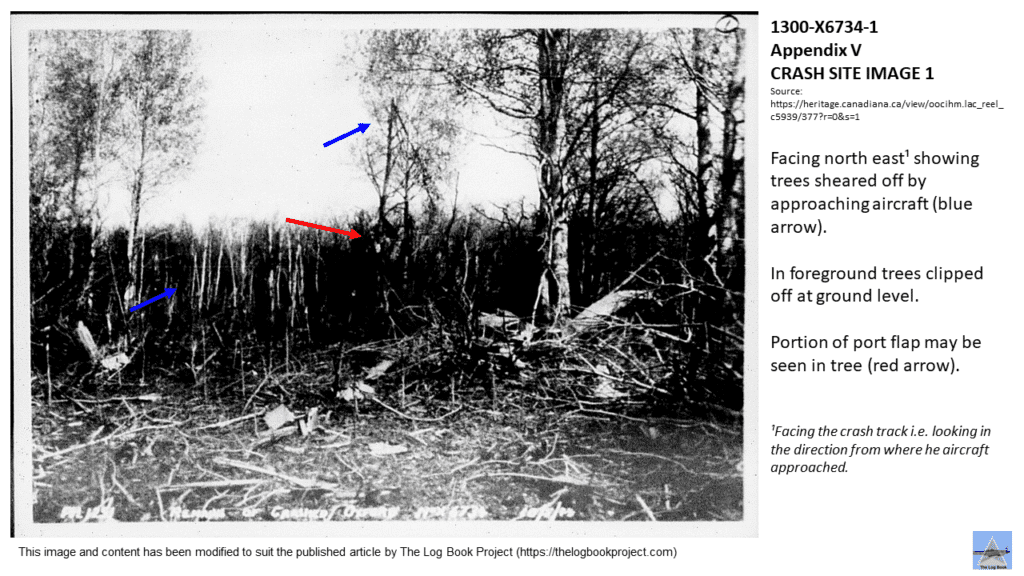
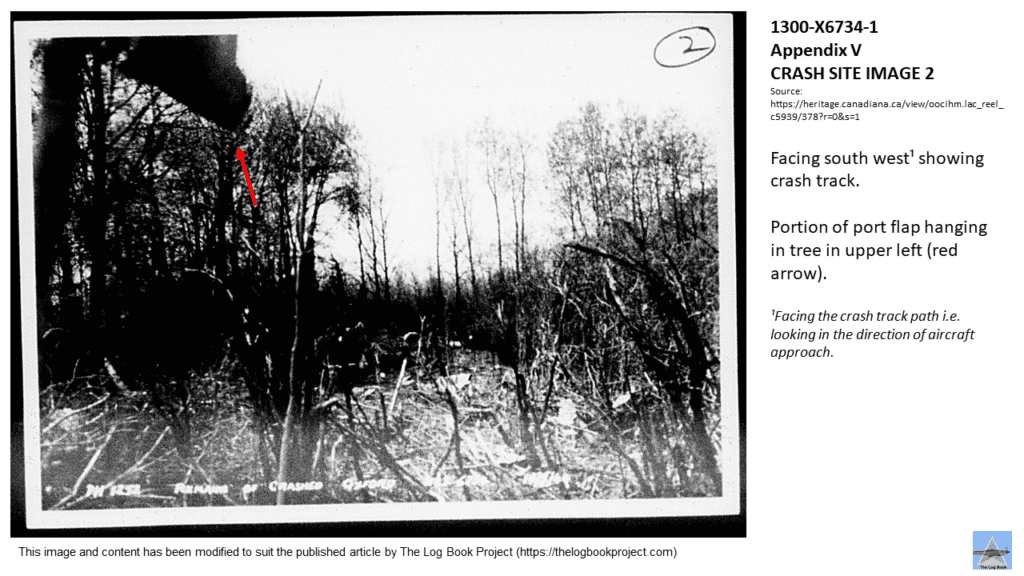
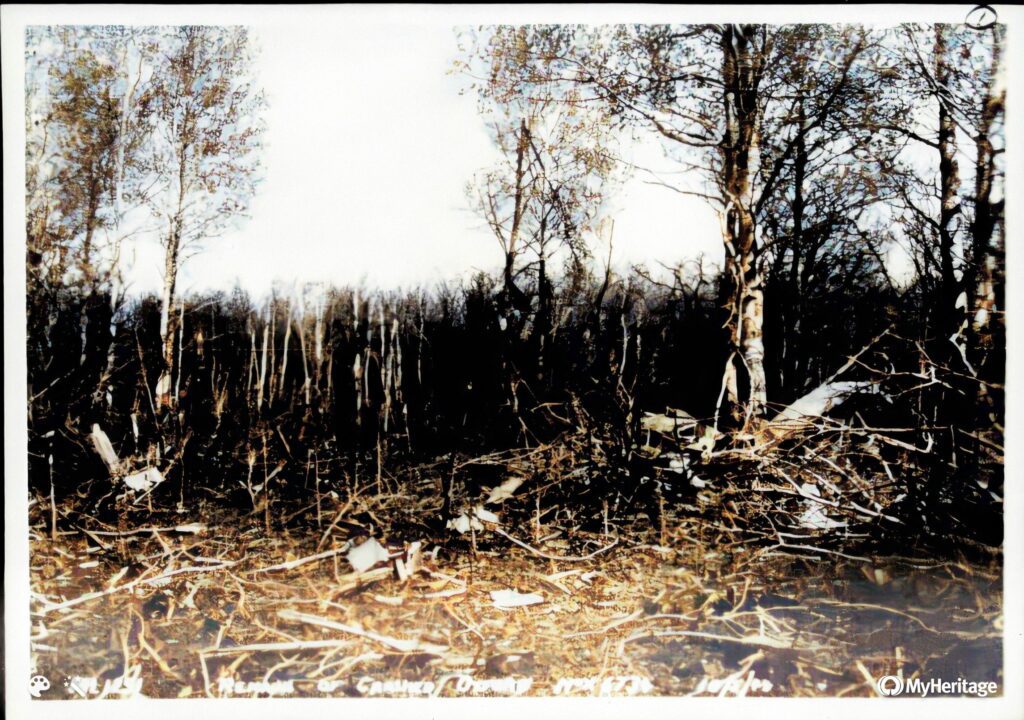
Both engines dug in about 75 feet from the first impact with trees, the aircraft disintegrated and caught fire which completed the demolition. It was clear that the aircraft was under considerable power based on the broken propellers. The ensuing fire consumes majority of the aircraft as the Oxford design utilized wood and fabric. The once bright yellow Oxford is reduced to charred metal parts and bits thrown clear of the main wreck site.
Testimony of P/O Kew (174607) – smoke and a near miss
On 4 May 1944 dense smoke from forest and bush fires had accumulated up north towards Edmonton. Although the existence of this smoke was part of pre-flight briefings there was no indication that the smoke would reach the Penhold area as the wind was blowing from a southerly direction. Later in the night there was a shift in direction and force of the wind resulting in that the smoke was now moving towards Penhold.
In the formal inquiry Pilot Officer Kew (174607) testifies how he on the same night was performing a similar dual night cross country training flight. He had taken off from No 36 SFTS Penhold at 21:20 with 2 pupils in Oxford AS803 and encounters smoke at Antross some 100 km north west of Penhold.
The only time on this flight I ran into smoke was at Antross. It was daylight at the time but the smoke was like a wall and very thick, though I was able to navigate through it. I cleared it some 10-15 miles east on the leg to Tofield.
P/O Frank Kew (174607), Flying instructor
Arriving back over No 36 SFTS Penhold a few minutes after midnight he finds the aerodrome in the clear with a fairly bright moon. He can however see smoke just touching the north side of Red Deer town spreading to the west towards the aerodrome. He cannot land as the runway is being changed, while making circuits at 2000′ the smoke reaches the aerodrome. In a matter of minutes the aerodrome becomes completely blacked out forcing him to reduce altitude to 700′ to maintain a visual with it.
In the smoke over the field he almost collides head on with another aircraft in the same predicament. In taking evasive actions to avoid the other aircraft P/O Kew turns right and looses sight of the field. He tries to find the field for 5 minutes but is never able to see it again. Low on fuel he turns south and performs a successful forced landing at 01:00 near Didsbury some 60 miles south of Penhold.
Testimony of F/Lt Mitchell – a close call
F/Lt Mitchell took off at 21:20 hours and with his pupil flew the same route that F/O Merry and LAC Conway would be flying later. The weather condition along the route is ideal, no smoke encountered and visibility was good. Similar conditions prevailed on his second flight over the same route which commenced at 22:20 and finished approximately at 23:40 hours.
Whilst waiting for his aircraft to be refueled message is received from the briefing room that smoke north of the aerodrome was now moving south. At around 23:55 he proceeded to his aircraft with the intention of carrying out a third Cross Country flight of the night. As he approached the aircraft he noticed large quantities of smoke drifting across the aerodrome and strong wind from the north west.
At that time F/Lt Mitchell informed Squadron Leader Thomson of the severely deteriorated weather conditions. All the night flying activities were immediately halted. At this time F/O Merry and LAC Conway was already airborne in Oxford X6734.
The aerodrome of No. 36 SFTS Penhold remains in dense smoke seeing little improvement in visibility over the next several hours.
The probable cause
Oxford X6734 with F/O Merry and LAC Conway took off between 23:35-23:46 just prior to the aerodrome changing runways. This was around F/Lt Mitchell’s landing but before F/O Kew’s arrival above aerodrome and it was only minutes before it become engulfed in smoke.
The takeoff conducted from runway 20 (200 deg heading) which is almost due south, away from the approaching smoke. There would have been no way for F/O Merry to observe the approaching smoke during take off or climb out on runway heading.
In the parts of wreckage without fire damage the Pilot Navigator’s Log Sheet for the flight is found. The last entry on the log shows that the aircraft reached an altitude of 5000′ over the base and had set course for Bashaw.
We will never know the exact details, but a fair speculation is that the initial climb after take off would have been on a south westerly course moving away from the approaching smoke. At some point they would have turned onto a north easterly heading towards their destination. In doing so their flight would now be heading directly for the approaching smoke, exactly where the flight encountered the smoke is undetermined.
The RCAF investigation concludes that the aircraft tried to return to its base but became lost. From observations at the scene of the crash it would appear that the pilot was forced to fly low in his search for land marks and in doing so crashed into the ground. It was apparent that the aircraft hit with “considerable force” and that it was flying level both fore and aft at the time.
The end and final resting place
F/O David Merry’s remains are found next to a tree inside the fire area with parts of the instrument panel and framework of both seats. Though badly charred the body has the safety harness done up and still wearing the parachute. He has suffered from multiple injuries and extensive burns which resulted in him being killed instantly.

At first there is no trace of pupil LAC Conway. His unlocked parachute and metal bucket portion of his seat with the Sutton Harness undone is found between the point of engine impact and the fire area.
Further survey of the woods adjacent to the crash his body is eventually found in a clearing some 200ft away. It is evident that LAC Conway has crawled from the crash to this spot. His hat was found in the dragging path he made, a package of chewing gum was also found on this path about 10 ft from the body.
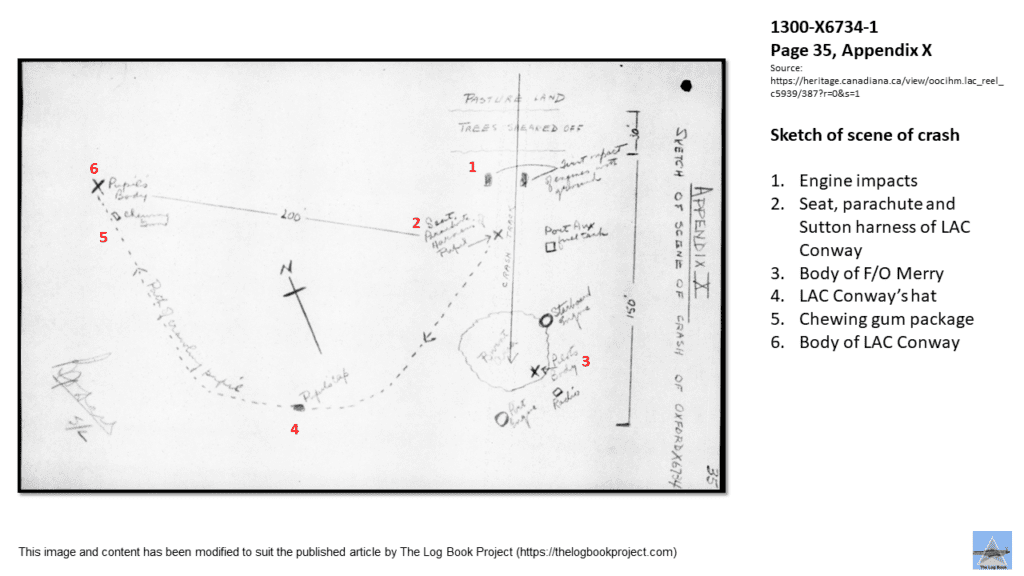
Apparently LAC Conway’s seat, with him in it, had broken away from its frame when the aircraft disintegrated after initial impact. He then managed to release his Sutton harness, unlock his parachute and crawl away from the scene. The harrowing reality is that LAC Conway managed to crawl a distance of 200ft with severe injuries that included a fractured neck. If any consolation it was determined that he had been dead 4-5 days when found i.e. time of death would have been shortly after the crash…in relative terms.
A funeral service is held on 12 May 1944 in St. Luke’s Church in Red Deer for F/O Merry and LAC Conway. Bearers were Officers from F/O Merry’s Flight and pupils from Course No. 101 in which LAC Conway was receiving instruction.
The burial took place at Red Deer Cemetery with full military honors.
Flying Officer David Merry (135135) and Leading Aircraftman George D. Conway (NZ435950) are both buried in Lot 7, Block F – they were 21 and 19 years old.
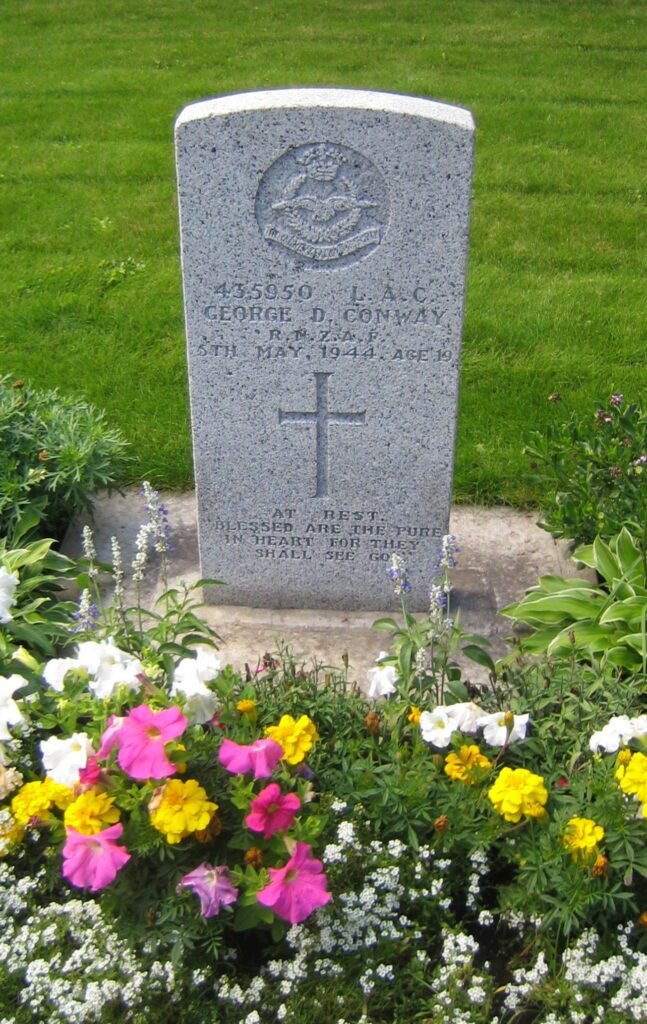
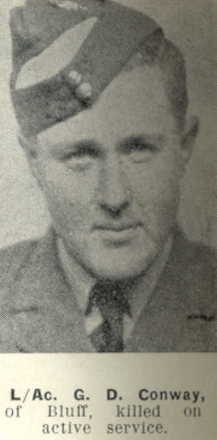
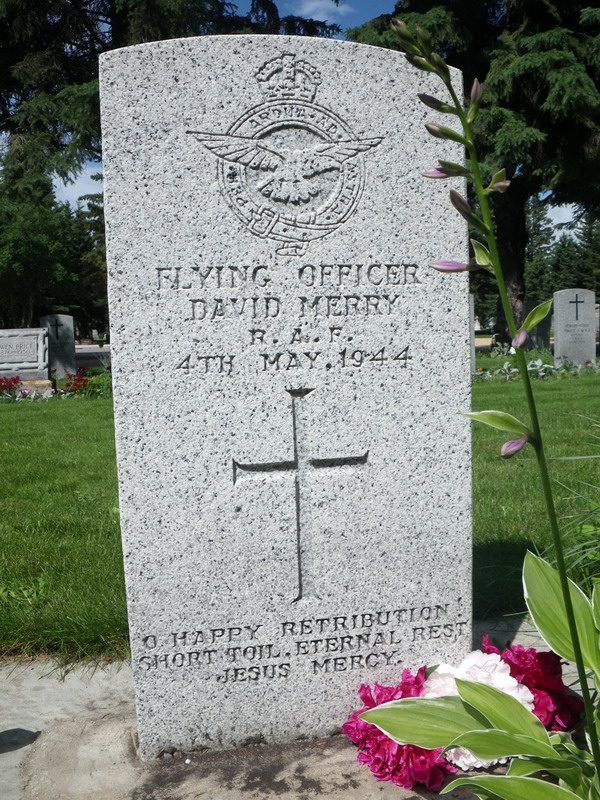
References
This article is in large parts based on the formal RCAF inquiry, 1300-X6734-1, conducted following the fatal accident.
A special thank you goes out to the Facebook group British Commonwealth Air Training Plan in Canada who provided swift and valuable direction in how to navigate archived RCAF records. It is through this group that we came in contact with Mr William Mackay of Harvard Historical Aviation Society who has provided invaluable assistance.

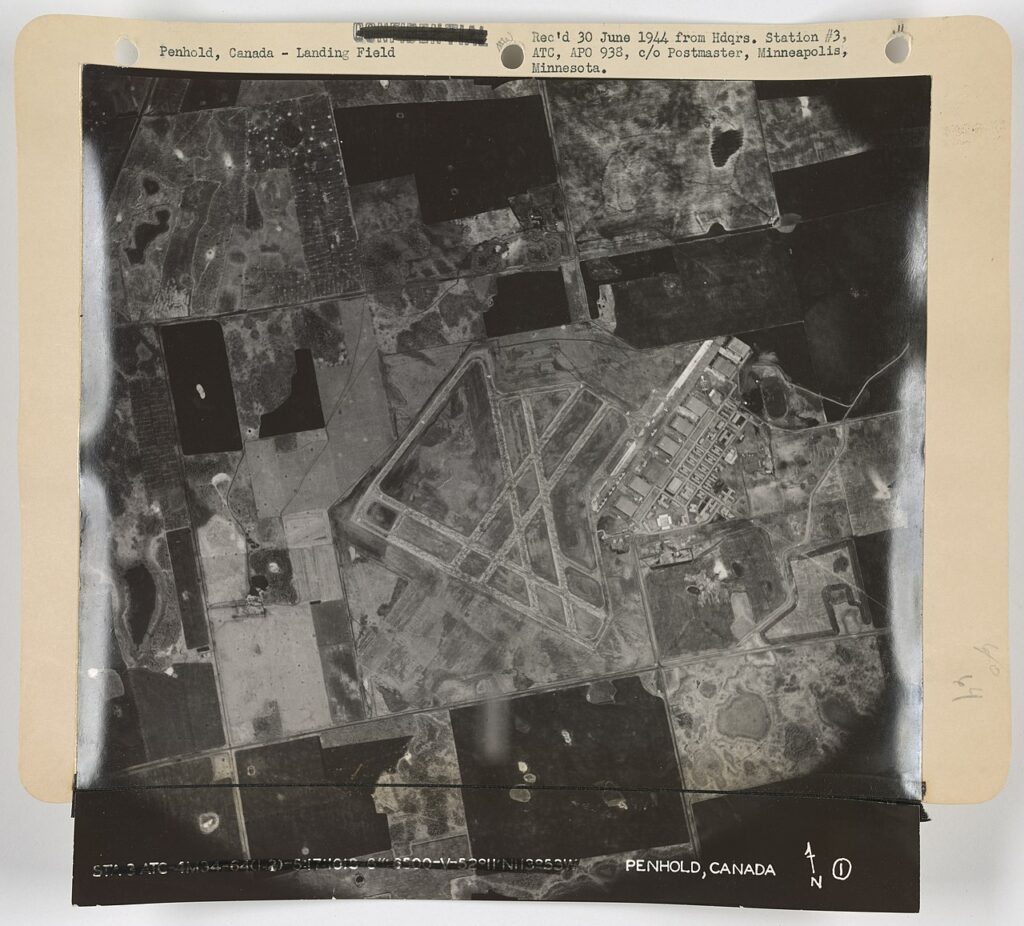

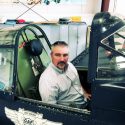
Be the first to comment